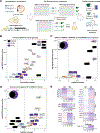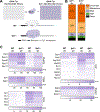Locus-specific proteome decoding reveals Fpt1 as a chromatin-associated negative regulator of RNA polymerase III assembly
- PMID: 37995691
- PMCID: PMC11289708
- DOI: 10.1016/j.molcel.2023.10.037
Locus-specific proteome decoding reveals Fpt1 as a chromatin-associated negative regulator of RNA polymerase III assembly
Abstract
Transcription of tRNA genes by RNA polymerase III (RNAPIII) is tuned by signaling cascades. The emerging notion of differential tRNA gene regulation implies the existence of additional regulatory mechanisms. However, tRNA gene-specific regulators have not been described. Decoding the local chromatin proteome of a native tRNA gene in yeast revealed reprogramming of the RNAPIII transcription machinery upon nutrient perturbation. Among the dynamic proteins, we identified Fpt1, a protein of unknown function that uniquely occupied RNAPIII-regulated genes. Fpt1 binding at tRNA genes correlated with the efficiency of RNAPIII eviction upon nutrient perturbation and required the transcription factors TFIIIB and TFIIIC but not RNAPIII. In the absence of Fpt1, eviction of RNAPIII was reduced, and the shutdown of ribosome biogenesis genes was impaired upon nutrient perturbation. Our findings provide support for a chromatin-associated mechanism required for RNAPIII eviction from tRNA genes and tuning the physiological response to changing metabolic demands.
Keywords: RNA polymerase III; chromatin; chromatin proteome; nutrient signaling; tDNA; tRNA; transcription.
Copyright © 2023 Elsevier Inc. All rights reserved.
Conflict of interest statement
Declaration of interests B.F.P. is an owner of and has a financial interest in Peconic, which uses the ChIP-exo technology (U.S. Patent 20100323361A1) implemented in this study and could potentially benefit from the outcomes of this research.
Figures







Similar articles
-
Cdk1 gates cell cycle-dependent tRNA synthesis by regulating RNA polymerase III activity.Nucleic Acids Res. 2018 Dec 14;46(22):11698-11711. doi: 10.1093/nar/gky846. Nucleic Acids Res. 2018. PMID: 30247619 Free PMC article.
-
Requirement of Nhp6 proteins for transcription of a subset of tRNA genes and heterochromatin barrier function in Saccharomyces cerevisiae.Mol Cell Biol. 2007 Mar;27(5):1545-57. doi: 10.1128/MCB.00773-06. Epub 2006 Dec 18. Mol Cell Biol. 2007. PMID: 17178828 Free PMC article.
-
The poly(A)-binding protein Nab2 functions in RNA polymerase III transcription.Genes Dev. 2015 Jul 15;29(14):1565-75. doi: 10.1101/gad.266205.115. Genes Dev. 2015. PMID: 26220998 Free PMC article.
-
Regulation of tRNA synthesis by posttranslational modifications of RNA polymerase III subunits.Biochim Biophys Acta Gene Regul Mech. 2018 Apr;1861(4):310-319. doi: 10.1016/j.bbagrm.2017.11.001. Epub 2017 Nov 7. Biochim Biophys Acta Gene Regul Mech. 2018. PMID: 29127063 Review.
-
Regulation of tRNA synthesis by the general transcription factors of RNA polymerase III - TFIIIB and TFIIIC, and by the MAF1 protein.Biochim Biophys Acta Gene Regul Mech. 2018 Apr;1861(4):320-329. doi: 10.1016/j.bbagrm.2018.01.011. Epub 2018 Feb 6. Biochim Biophys Acta Gene Regul Mech. 2018. PMID: 29378333 Review.
Cited by
-
Non-Coding RNAs: Regulators of Stress, Ageing, and Developmental Decisions in Yeast?Cells. 2024 Mar 29;13(7):599. doi: 10.3390/cells13070599. Cells. 2024. PMID: 38607038 Free PMC article. Review.
-
The choreography of chromatin in RNA polymerase III regulation.Biochem Soc Trans. 2024 Jun 26;52(3):1173-1189. doi: 10.1042/BST20230770. Biochem Soc Trans. 2024. PMID: 38666598 Free PMC article. Review.
-
Unraveling the regulatory dynamics of bidirectional promoters for modulating gene co-expression and metabolic flux in Saccharomyces cerevisiae.Nucleic Acids Res. 2025 Jun 6;53(11):gkaf511. doi: 10.1093/nar/gkaf511. Nucleic Acids Res. 2025. PMID: 40503683 Free PMC article.
-
Should I stay or should I go: TFIIIC as assembly factor and barrier in RNA polymerase III transcription.Biochem Soc Trans. 2025 Aug 29;53(4):925-934. doi: 10.1042/BST20253058. Biochem Soc Trans. 2025. PMID: 40762516 Free PMC article. Review.
References
MeSH terms
Substances
Grants and funding
LinkOut - more resources
Full Text Sources
Molecular Biology Databases

